Analysis of Business Operations: Virgin Atlantic Airways and Tesco
VerifiedAdded on 2020/11/23
|11
|2476
|488
Report
AI Summary
This report provides a detailed analysis of business operations, using Virgin Atlantic Airways as a primary case study. It covers essential aspects such as accounting practices, including profit and loss interpretation; human resource functions, encompassing recruitment, training, and employment legislation; and customer service strategies. The report also explores different leadership styles, team development stages, and motivation theories, offering insights into how these elements contribute to overall business success. Furthermore, it highlights the importance of customer profiling and its benefits. The report concludes with a summary of the key findings, emphasizing the interconnectedness of these operational components.
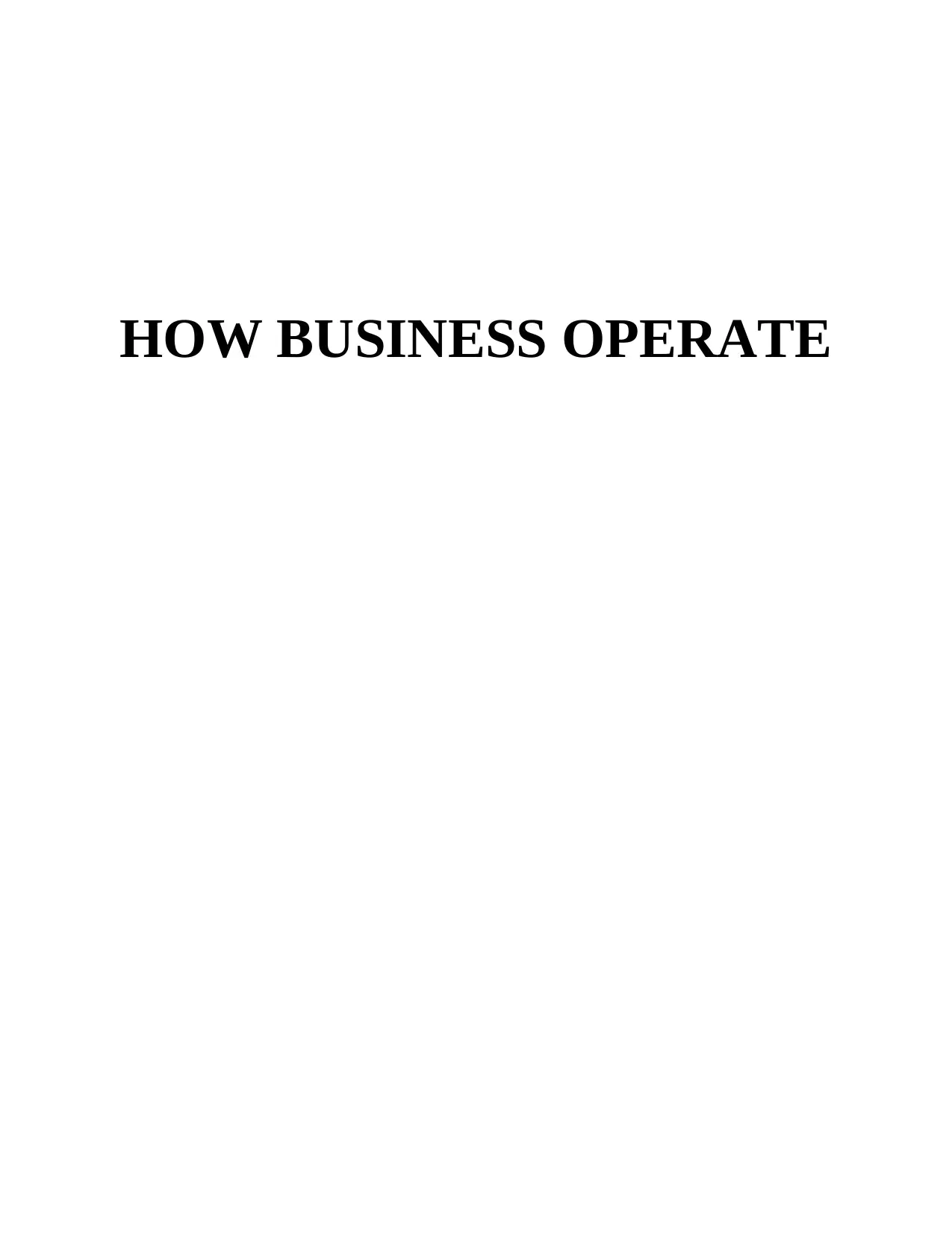
HOW BUSINESS OPERATE
Paraphrase This Document
Need a fresh take? Get an instant paraphrase of this document with our AI Paraphraser
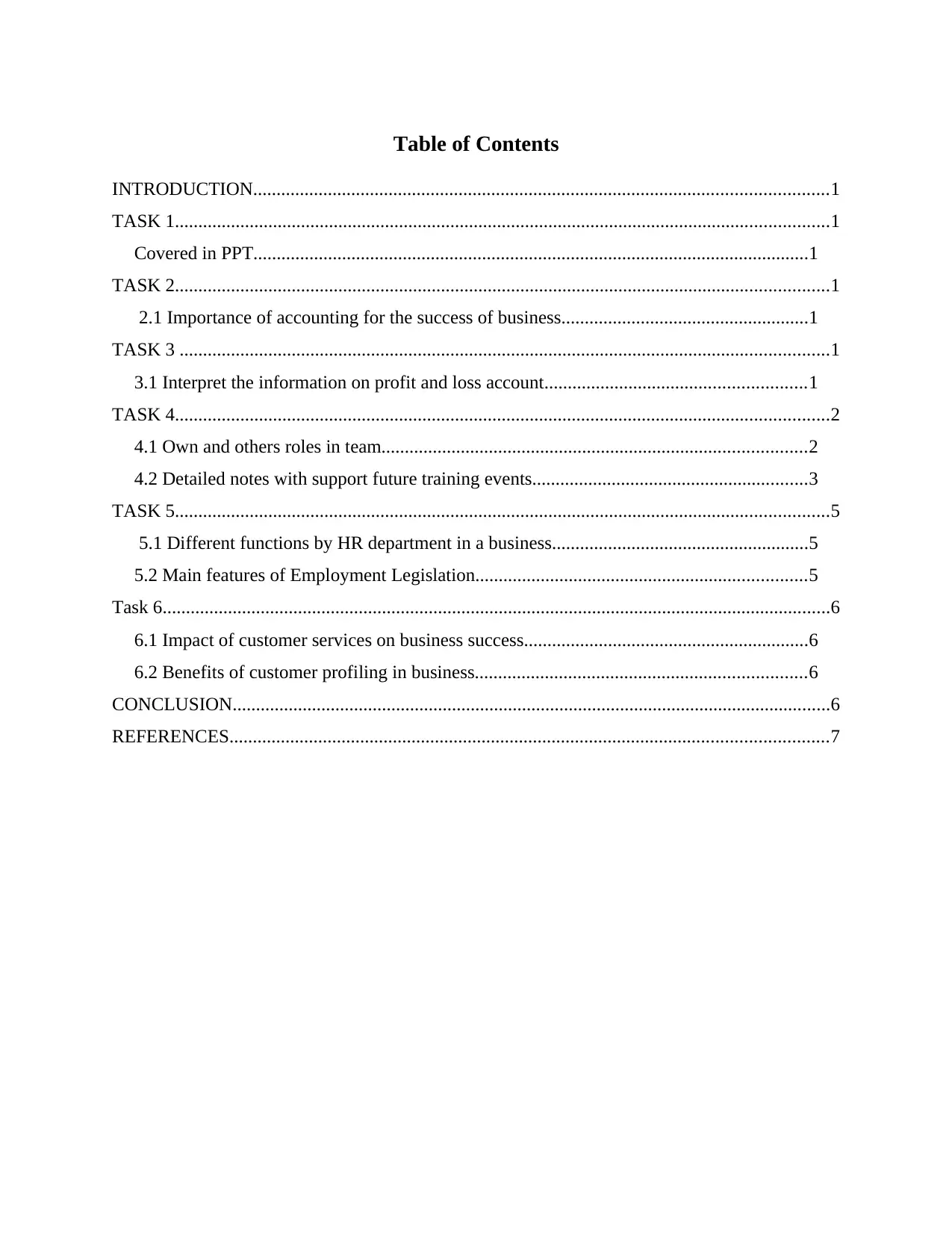
Table of Contents
INTRODUCTION...........................................................................................................................1
TASK 1............................................................................................................................................1
Covered in PPT.......................................................................................................................1
TASK 2............................................................................................................................................1
2.1 Importance of accounting for the success of business.....................................................1
TASK 3 ...........................................................................................................................................1
3.1 Interpret the information on profit and loss account........................................................1
TASK 4............................................................................................................................................2
4.1 Own and others roles in team...........................................................................................2
4.2 Detailed notes with support future training events...........................................................3
TASK 5............................................................................................................................................5
5.1 Different functions by HR department in a business.......................................................5
5.2 Main features of Employment Legislation.......................................................................5
Task 6...............................................................................................................................................6
6.1 Impact of customer services on business success.............................................................6
6.2 Benefits of customer profiling in business.......................................................................6
CONCLUSION................................................................................................................................6
REFERENCES................................................................................................................................7
INTRODUCTION...........................................................................................................................1
TASK 1............................................................................................................................................1
Covered in PPT.......................................................................................................................1
TASK 2............................................................................................................................................1
2.1 Importance of accounting for the success of business.....................................................1
TASK 3 ...........................................................................................................................................1
3.1 Interpret the information on profit and loss account........................................................1
TASK 4............................................................................................................................................2
4.1 Own and others roles in team...........................................................................................2
4.2 Detailed notes with support future training events...........................................................3
TASK 5............................................................................................................................................5
5.1 Different functions by HR department in a business.......................................................5
5.2 Main features of Employment Legislation.......................................................................5
Task 6...............................................................................................................................................6
6.1 Impact of customer services on business success.............................................................6
6.2 Benefits of customer profiling in business.......................................................................6
CONCLUSION................................................................................................................................6
REFERENCES................................................................................................................................7

⊘ This is a preview!⊘
Do you want full access?
Subscribe today to unlock all pages.

Trusted by 1+ million students worldwide
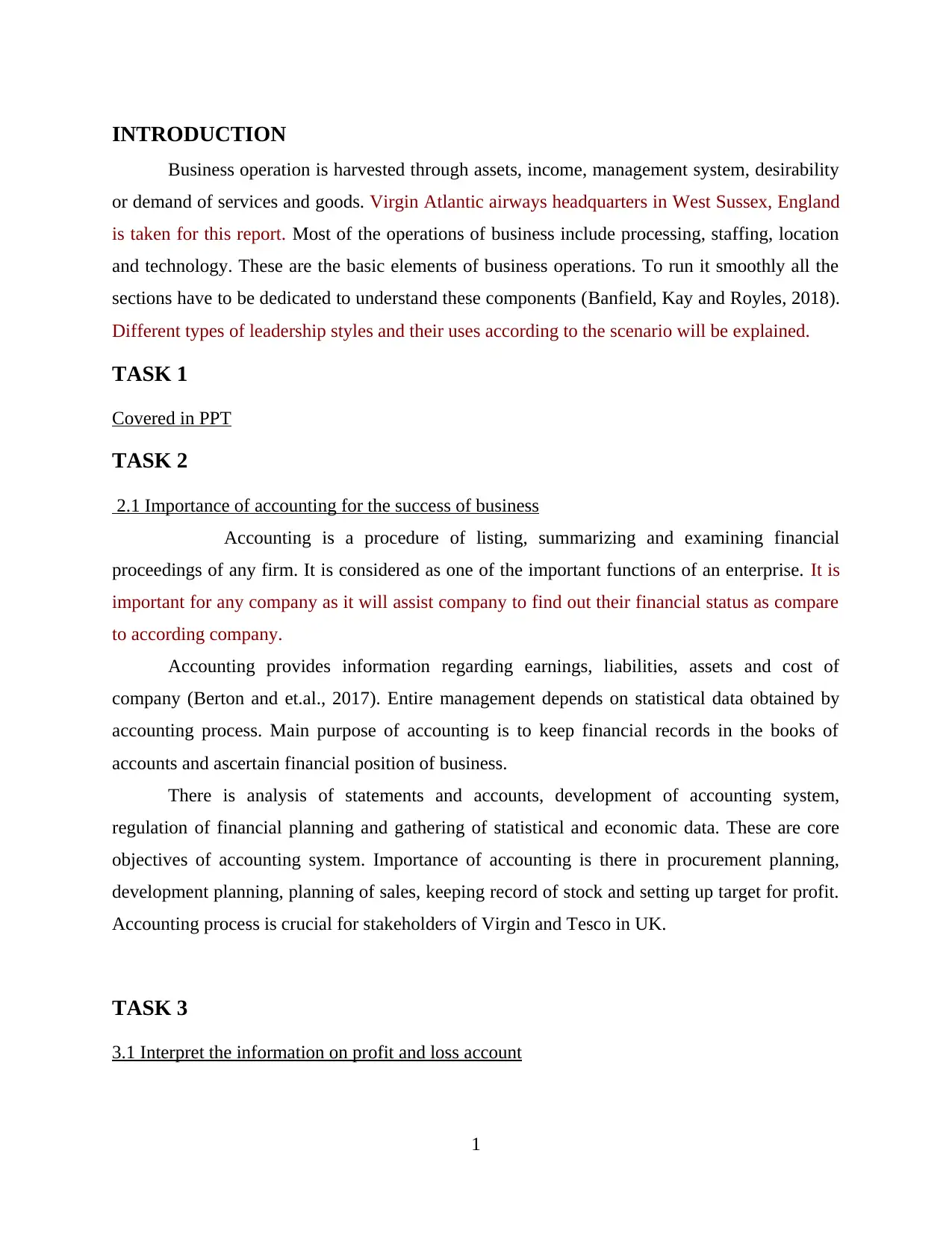
INTRODUCTION
Business operation is harvested through assets, income, management system, desirability
or demand of services and goods. Virgin Atlantic airways headquarters in West Sussex, England
is taken for this report. Most of the operations of business include processing, staffing, location
and technology. These are the basic elements of business operations. To run it smoothly all the
sections have to be dedicated to understand these components (Banfield, Kay and Royles, 2018).
Different types of leadership styles and their uses according to the scenario will be explained.
TASK 1
Covered in PPT
TASK 2
2.1 Importance of accounting for the success of business
Accounting is a procedure of listing, summarizing and examining financial
proceedings of any firm. It is considered as one of the important functions of an enterprise. It is
important for any company as it will assist company to find out their financial status as compare
to according company.
Accounting provides information regarding earnings, liabilities, assets and cost of
company (Berton and et.al., 2017). Entire management depends on statistical data obtained by
accounting process. Main purpose of accounting is to keep financial records in the books of
accounts and ascertain financial position of business.
There is analysis of statements and accounts, development of accounting system,
regulation of financial planning and gathering of statistical and economic data. These are core
objectives of accounting system. Importance of accounting is there in procurement planning,
development planning, planning of sales, keeping record of stock and setting up target for profit.
Accounting process is crucial for stakeholders of Virgin and Tesco in UK.
TASK 3
3.1 Interpret the information on profit and loss account
1
Business operation is harvested through assets, income, management system, desirability
or demand of services and goods. Virgin Atlantic airways headquarters in West Sussex, England
is taken for this report. Most of the operations of business include processing, staffing, location
and technology. These are the basic elements of business operations. To run it smoothly all the
sections have to be dedicated to understand these components (Banfield, Kay and Royles, 2018).
Different types of leadership styles and their uses according to the scenario will be explained.
TASK 1
Covered in PPT
TASK 2
2.1 Importance of accounting for the success of business
Accounting is a procedure of listing, summarizing and examining financial
proceedings of any firm. It is considered as one of the important functions of an enterprise. It is
important for any company as it will assist company to find out their financial status as compare
to according company.
Accounting provides information regarding earnings, liabilities, assets and cost of
company (Berton and et.al., 2017). Entire management depends on statistical data obtained by
accounting process. Main purpose of accounting is to keep financial records in the books of
accounts and ascertain financial position of business.
There is analysis of statements and accounts, development of accounting system,
regulation of financial planning and gathering of statistical and economic data. These are core
objectives of accounting system. Importance of accounting is there in procurement planning,
development planning, planning of sales, keeping record of stock and setting up target for profit.
Accounting process is crucial for stakeholders of Virgin and Tesco in UK.
TASK 3
3.1 Interpret the information on profit and loss account
1
Paraphrase This Document
Need a fresh take? Get an instant paraphrase of this document with our AI Paraphraser
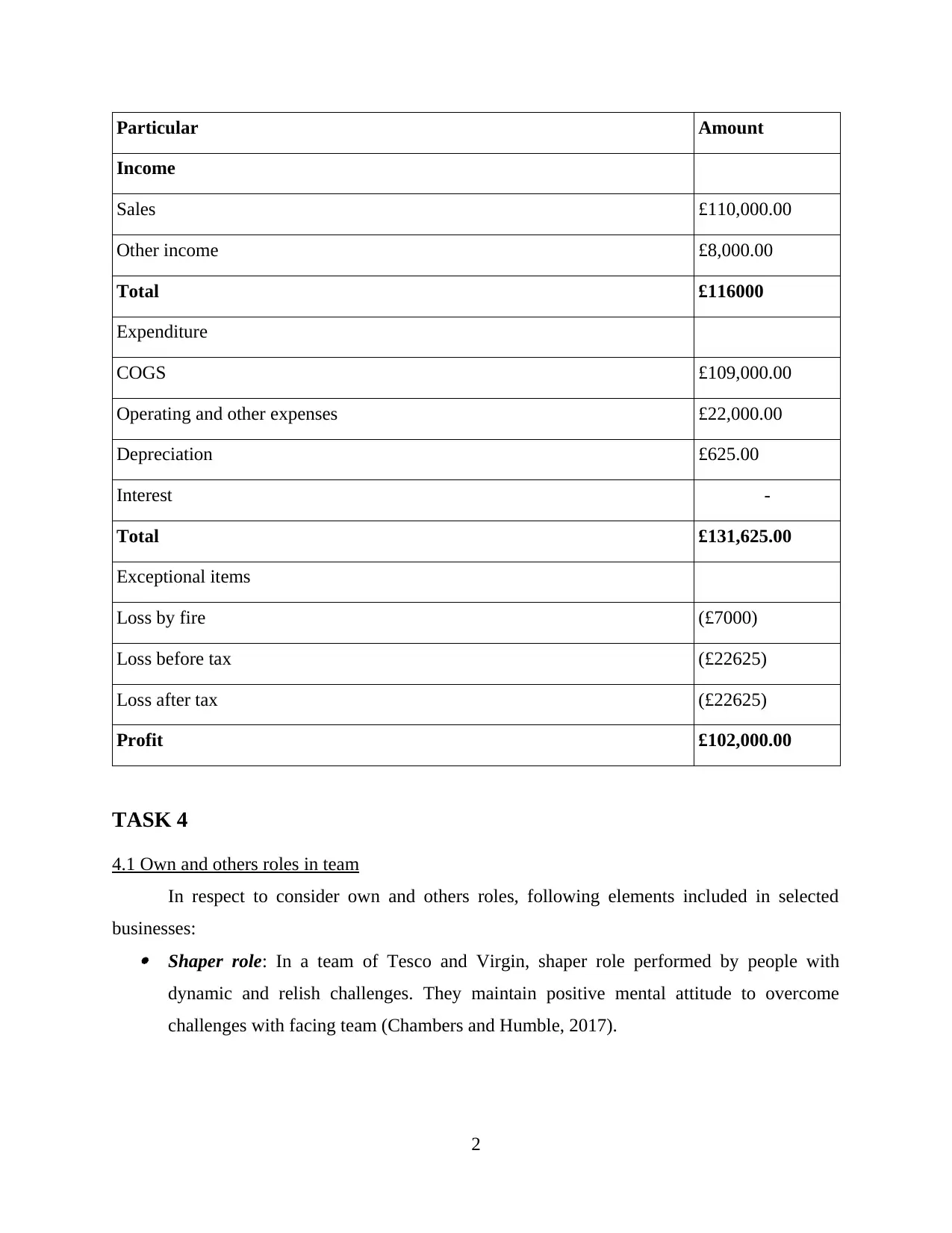
Particular Amount
Income
Sales £110,000.00
Other income £8,000.00
Total £116000
Expenditure
COGS £109,000.00
Operating and other expenses £22,000.00
Depreciation £625.00
Interest -
Total £131,625.00
Exceptional items
Loss by fire (£7000)
Loss before tax (£22625)
Loss after tax (£22625)
Profit £102,000.00
TASK 4
4.1 Own and others roles in team
In respect to consider own and others roles, following elements included in selected
businesses: Shaper role: In a team of Tesco and Virgin, shaper role performed by people with
dynamic and relish challenges. They maintain positive mental attitude to overcome
challenges with facing team (Chambers and Humble, 2017).
2
Income
Sales £110,000.00
Other income £8,000.00
Total £116000
Expenditure
COGS £109,000.00
Operating and other expenses £22,000.00
Depreciation £625.00
Interest -
Total £131,625.00
Exceptional items
Loss by fire (£7000)
Loss before tax (£22625)
Loss after tax (£22625)
Profit £102,000.00
TASK 4
4.1 Own and others roles in team
In respect to consider own and others roles, following elements included in selected
businesses: Shaper role: In a team of Tesco and Virgin, shaper role performed by people with
dynamic and relish challenges. They maintain positive mental attitude to overcome
challenges with facing team (Chambers and Humble, 2017).
2
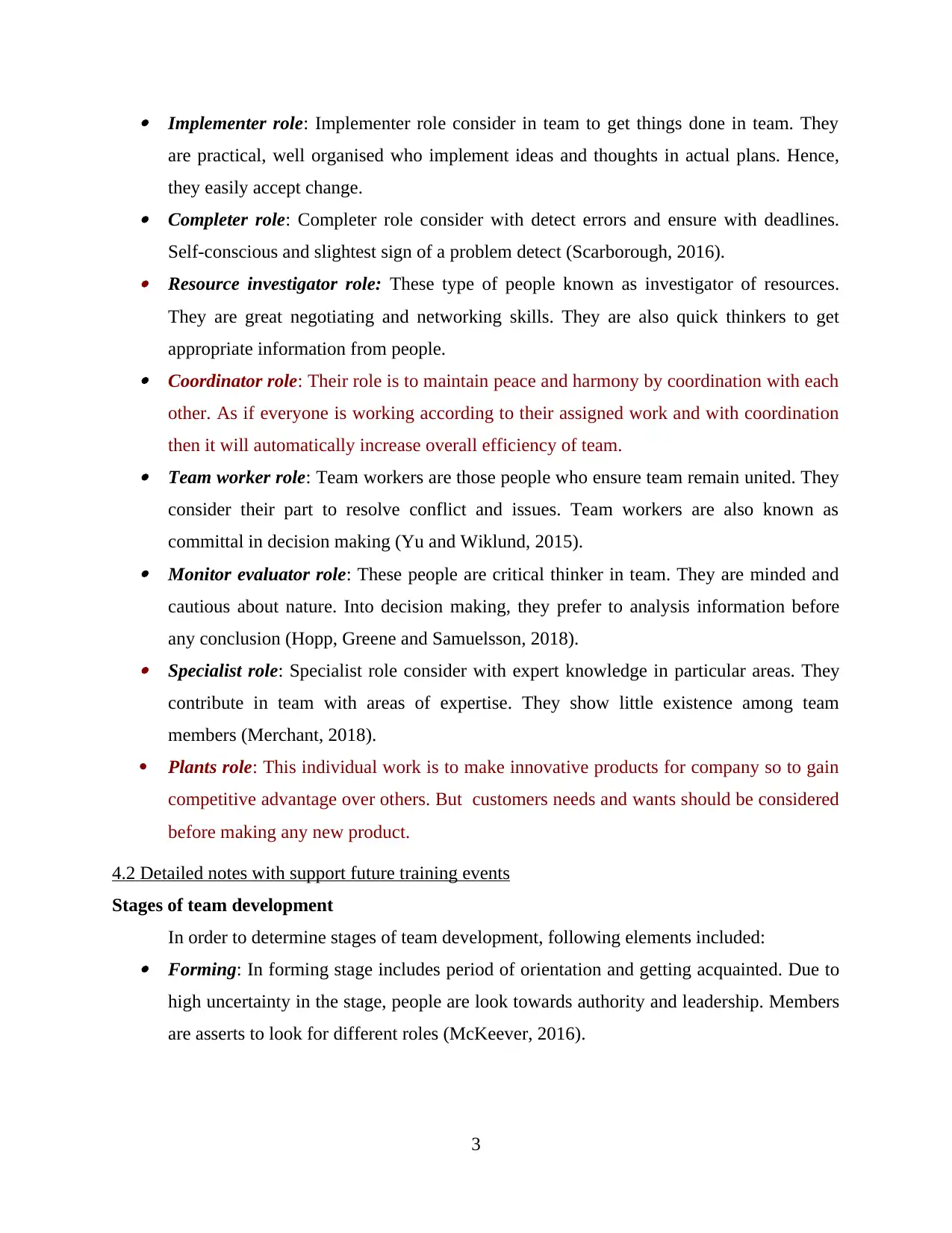
Implementer role: Implementer role consider in team to get things done in team. They
are practical, well organised who implement ideas and thoughts in actual plans. Hence,
they easily accept change. Completer role: Completer role consider with detect errors and ensure with deadlines.
Self-conscious and slightest sign of a problem detect (Scarborough, 2016). Resource investigator role: These type of people known as investigator of resources.
They are great negotiating and networking skills. They are also quick thinkers to get
appropriate information from people. Coordinator role: Their role is to maintain peace and harmony by coordination with each
other. As if everyone is working according to their assigned work and with coordination
then it will automatically increase overall efficiency of team. Team worker role: Team workers are those people who ensure team remain united. They
consider their part to resolve conflict and issues. Team workers are also known as
committal in decision making (Yu and Wiklund, 2015). Monitor evaluator role: These people are critical thinker in team. They are minded and
cautious about nature. Into decision making, they prefer to analysis information before
any conclusion (Hopp, Greene and Samuelsson, 2018). Specialist role: Specialist role consider with expert knowledge in particular areas. They
contribute in team with areas of expertise. They show little existence among team
members (Merchant, 2018).
Plants role: This individual work is to make innovative products for company so to gain
competitive advantage over others. But customers needs and wants should be considered
before making any new product.
4.2 Detailed notes with support future training events
Stages of team development
In order to determine stages of team development, following elements included: Forming: In forming stage includes period of orientation and getting acquainted. Due to
high uncertainty in the stage, people are look towards authority and leadership. Members
are asserts to look for different roles (McKeever, 2016).
3
are practical, well organised who implement ideas and thoughts in actual plans. Hence,
they easily accept change. Completer role: Completer role consider with detect errors and ensure with deadlines.
Self-conscious and slightest sign of a problem detect (Scarborough, 2016). Resource investigator role: These type of people known as investigator of resources.
They are great negotiating and networking skills. They are also quick thinkers to get
appropriate information from people. Coordinator role: Their role is to maintain peace and harmony by coordination with each
other. As if everyone is working according to their assigned work and with coordination
then it will automatically increase overall efficiency of team. Team worker role: Team workers are those people who ensure team remain united. They
consider their part to resolve conflict and issues. Team workers are also known as
committal in decision making (Yu and Wiklund, 2015). Monitor evaluator role: These people are critical thinker in team. They are minded and
cautious about nature. Into decision making, they prefer to analysis information before
any conclusion (Hopp, Greene and Samuelsson, 2018). Specialist role: Specialist role consider with expert knowledge in particular areas. They
contribute in team with areas of expertise. They show little existence among team
members (Merchant, 2018).
Plants role: This individual work is to make innovative products for company so to gain
competitive advantage over others. But customers needs and wants should be considered
before making any new product.
4.2 Detailed notes with support future training events
Stages of team development
In order to determine stages of team development, following elements included: Forming: In forming stage includes period of orientation and getting acquainted. Due to
high uncertainty in the stage, people are look towards authority and leadership. Members
are asserts to look for different roles (McKeever, 2016).
3
⊘ This is a preview!⊘
Do you want full access?
Subscribe today to unlock all pages.

Trusted by 1+ million students worldwide
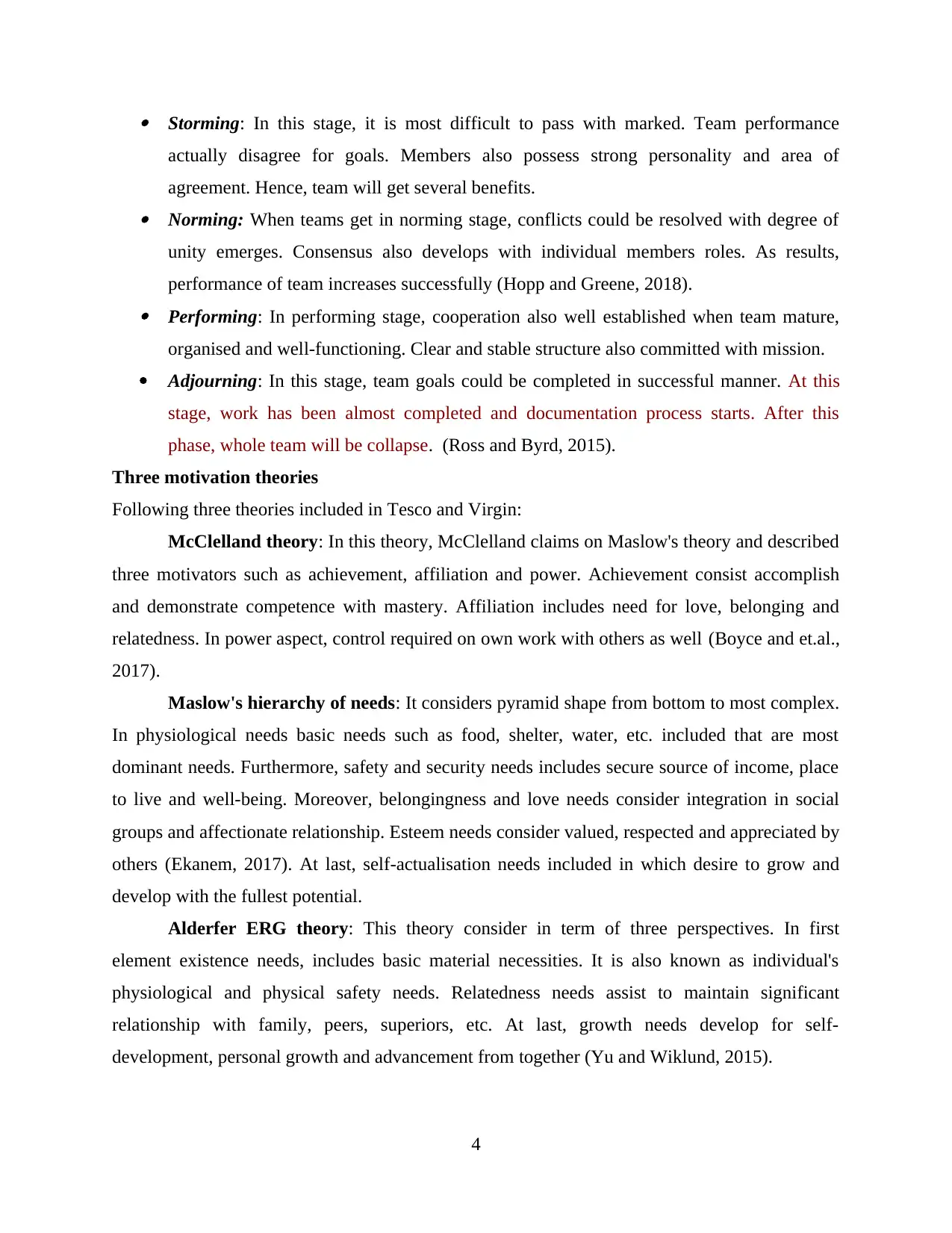
Storming: In this stage, it is most difficult to pass with marked. Team performance
actually disagree for goals. Members also possess strong personality and area of
agreement. Hence, team will get several benefits. Norming: When teams get in norming stage, conflicts could be resolved with degree of
unity emerges. Consensus also develops with individual members roles. As results,
performance of team increases successfully (Hopp and Greene, 2018). Performing: In performing stage, cooperation also well established when team mature,
organised and well-functioning. Clear and stable structure also committed with mission.
Adjourning: In this stage, team goals could be completed in successful manner. At this
stage, work has been almost completed and documentation process starts. After this
phase, whole team will be collapse. (Ross and Byrd, 2015).
Three motivation theories
Following three theories included in Tesco and Virgin:
McClelland theory: In this theory, McClelland claims on Maslow's theory and described
three motivators such as achievement, affiliation and power. Achievement consist accomplish
and demonstrate competence with mastery. Affiliation includes need for love, belonging and
relatedness. In power aspect, control required on own work with others as well (Boyce and et.al.,
2017).
Maslow's hierarchy of needs: It considers pyramid shape from bottom to most complex.
In physiological needs basic needs such as food, shelter, water, etc. included that are most
dominant needs. Furthermore, safety and security needs includes secure source of income, place
to live and well-being. Moreover, belongingness and love needs consider integration in social
groups and affectionate relationship. Esteem needs consider valued, respected and appreciated by
others (Ekanem, 2017). At last, self-actualisation needs included in which desire to grow and
develop with the fullest potential.
Alderfer ERG theory: This theory consider in term of three perspectives. In first
element existence needs, includes basic material necessities. It is also known as individual's
physiological and physical safety needs. Relatedness needs assist to maintain significant
relationship with family, peers, superiors, etc. At last, growth needs develop for self-
development, personal growth and advancement from together (Yu and Wiklund, 2015).
4
actually disagree for goals. Members also possess strong personality and area of
agreement. Hence, team will get several benefits. Norming: When teams get in norming stage, conflicts could be resolved with degree of
unity emerges. Consensus also develops with individual members roles. As results,
performance of team increases successfully (Hopp and Greene, 2018). Performing: In performing stage, cooperation also well established when team mature,
organised and well-functioning. Clear and stable structure also committed with mission.
Adjourning: In this stage, team goals could be completed in successful manner. At this
stage, work has been almost completed and documentation process starts. After this
phase, whole team will be collapse. (Ross and Byrd, 2015).
Three motivation theories
Following three theories included in Tesco and Virgin:
McClelland theory: In this theory, McClelland claims on Maslow's theory and described
three motivators such as achievement, affiliation and power. Achievement consist accomplish
and demonstrate competence with mastery. Affiliation includes need for love, belonging and
relatedness. In power aspect, control required on own work with others as well (Boyce and et.al.,
2017).
Maslow's hierarchy of needs: It considers pyramid shape from bottom to most complex.
In physiological needs basic needs such as food, shelter, water, etc. included that are most
dominant needs. Furthermore, safety and security needs includes secure source of income, place
to live and well-being. Moreover, belongingness and love needs consider integration in social
groups and affectionate relationship. Esteem needs consider valued, respected and appreciated by
others (Ekanem, 2017). At last, self-actualisation needs included in which desire to grow and
develop with the fullest potential.
Alderfer ERG theory: This theory consider in term of three perspectives. In first
element existence needs, includes basic material necessities. It is also known as individual's
physiological and physical safety needs. Relatedness needs assist to maintain significant
relationship with family, peers, superiors, etc. At last, growth needs develop for self-
development, personal growth and advancement from together (Yu and Wiklund, 2015).
4
Paraphrase This Document
Need a fresh take? Get an instant paraphrase of this document with our AI Paraphraser
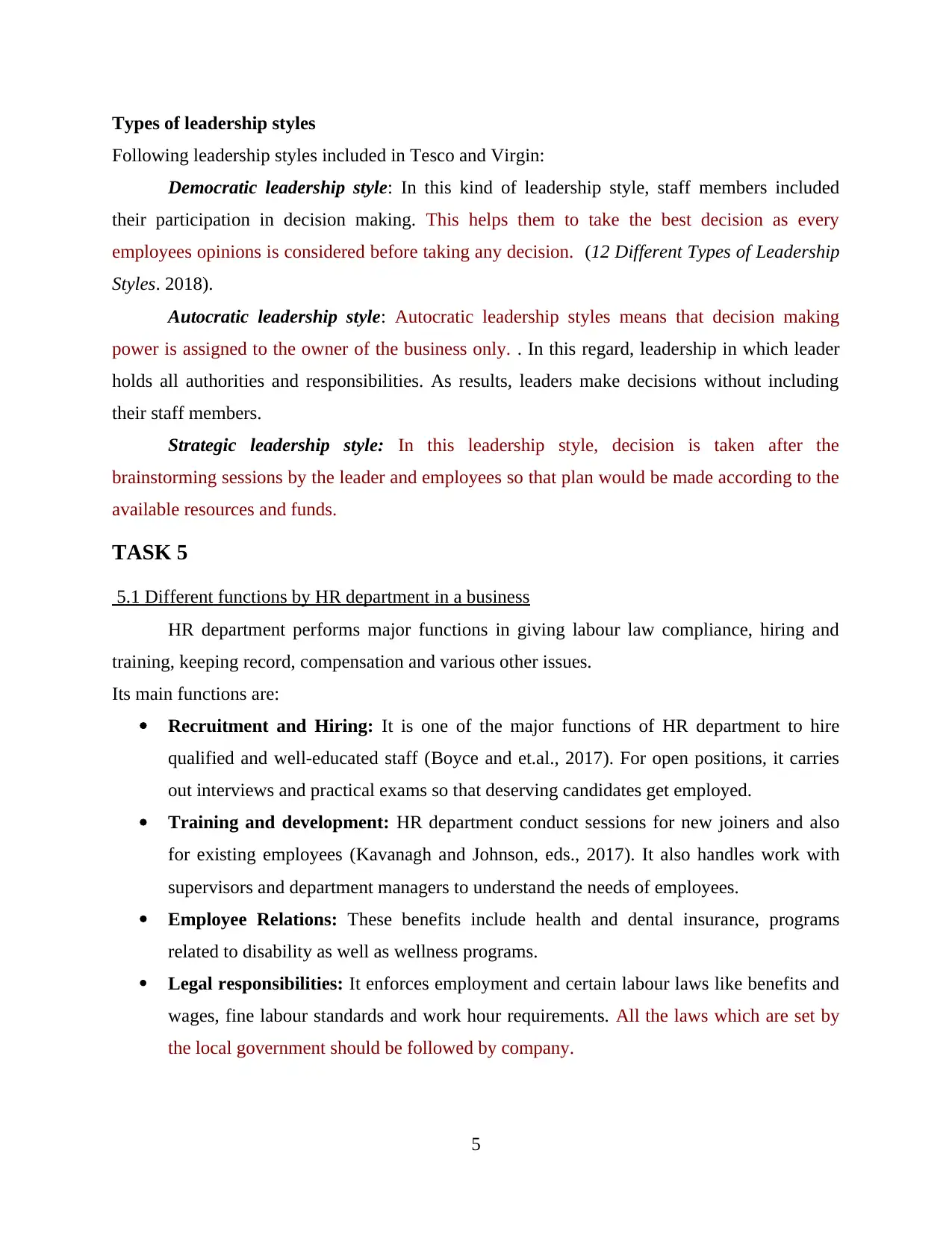
Types of leadership styles
Following leadership styles included in Tesco and Virgin:
Democratic leadership style: In this kind of leadership style, staff members included
their participation in decision making. This helps them to take the best decision as every
employees opinions is considered before taking any decision. (12 Different Types of Leadership
Styles. 2018).
Autocratic leadership style: Autocratic leadership styles means that decision making
power is assigned to the owner of the business only. . In this regard, leadership in which leader
holds all authorities and responsibilities. As results, leaders make decisions without including
their staff members.
Strategic leadership style: In this leadership style, decision is taken after the
brainstorming sessions by the leader and employees so that plan would be made according to the
available resources and funds.
TASK 5
5.1 Different functions by HR department in a business
HR department performs major functions in giving labour law compliance, hiring and
training, keeping record, compensation and various other issues.
Its main functions are:
Recruitment and Hiring: It is one of the major functions of HR department to hire
qualified and well-educated staff (Boyce and et.al., 2017). For open positions, it carries
out interviews and practical exams so that deserving candidates get employed.
Training and development: HR department conduct sessions for new joiners and also
for existing employees (Kavanagh and Johnson, eds., 2017). It also handles work with
supervisors and department managers to understand the needs of employees.
Employee Relations: These benefits include health and dental insurance, programs
related to disability as well as wellness programs.
Legal responsibilities: It enforces employment and certain labour laws like benefits and
wages, fine labour standards and work hour requirements. All the laws which are set by
the local government should be followed by company.
5
Following leadership styles included in Tesco and Virgin:
Democratic leadership style: In this kind of leadership style, staff members included
their participation in decision making. This helps them to take the best decision as every
employees opinions is considered before taking any decision. (12 Different Types of Leadership
Styles. 2018).
Autocratic leadership style: Autocratic leadership styles means that decision making
power is assigned to the owner of the business only. . In this regard, leadership in which leader
holds all authorities and responsibilities. As results, leaders make decisions without including
their staff members.
Strategic leadership style: In this leadership style, decision is taken after the
brainstorming sessions by the leader and employees so that plan would be made according to the
available resources and funds.
TASK 5
5.1 Different functions by HR department in a business
HR department performs major functions in giving labour law compliance, hiring and
training, keeping record, compensation and various other issues.
Its main functions are:
Recruitment and Hiring: It is one of the major functions of HR department to hire
qualified and well-educated staff (Boyce and et.al., 2017). For open positions, it carries
out interviews and practical exams so that deserving candidates get employed.
Training and development: HR department conduct sessions for new joiners and also
for existing employees (Kavanagh and Johnson, eds., 2017). It also handles work with
supervisors and department managers to understand the needs of employees.
Employee Relations: These benefits include health and dental insurance, programs
related to disability as well as wellness programs.
Legal responsibilities: It enforces employment and certain labour laws like benefits and
wages, fine labour standards and work hour requirements. All the laws which are set by
the local government should be followed by company.
5
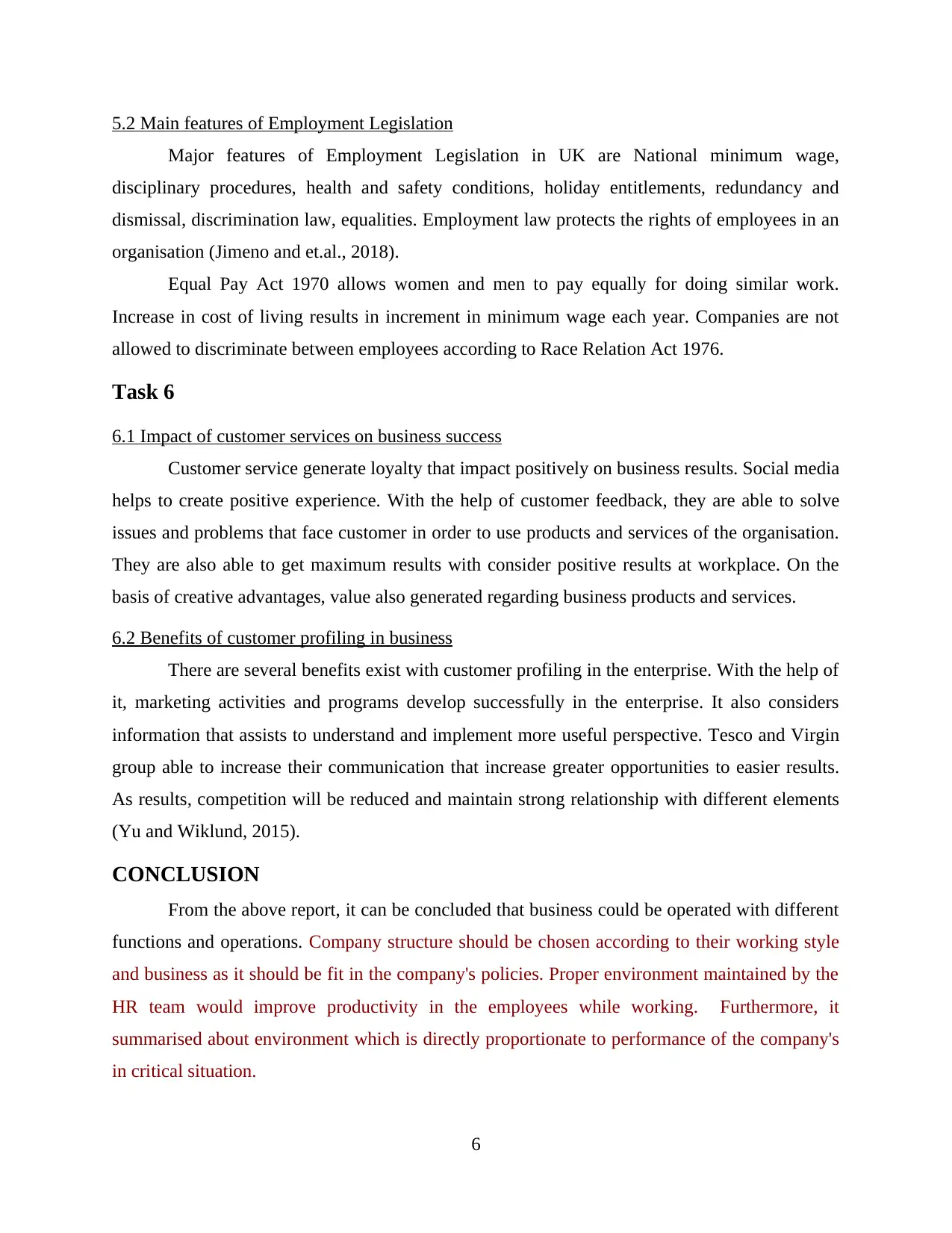
5.2 Main features of Employment Legislation
Major features of Employment Legislation in UK are National minimum wage,
disciplinary procedures, health and safety conditions, holiday entitlements, redundancy and
dismissal, discrimination law, equalities. Employment law protects the rights of employees in an
organisation (Jimeno and et.al., 2018).
Equal Pay Act 1970 allows women and men to pay equally for doing similar work.
Increase in cost of living results in increment in minimum wage each year. Companies are not
allowed to discriminate between employees according to Race Relation Act 1976.
Task 6
6.1 Impact of customer services on business success
Customer service generate loyalty that impact positively on business results. Social media
helps to create positive experience. With the help of customer feedback, they are able to solve
issues and problems that face customer in order to use products and services of the organisation.
They are also able to get maximum results with consider positive results at workplace. On the
basis of creative advantages, value also generated regarding business products and services.
6.2 Benefits of customer profiling in business
There are several benefits exist with customer profiling in the enterprise. With the help of
it, marketing activities and programs develop successfully in the enterprise. It also considers
information that assists to understand and implement more useful perspective. Tesco and Virgin
group able to increase their communication that increase greater opportunities to easier results.
As results, competition will be reduced and maintain strong relationship with different elements
(Yu and Wiklund, 2015).
CONCLUSION
From the above report, it can be concluded that business could be operated with different
functions and operations. Company structure should be chosen according to their working style
and business as it should be fit in the company's policies. Proper environment maintained by the
HR team would improve productivity in the employees while working. Furthermore, it
summarised about environment which is directly proportionate to performance of the company's
in critical situation.
6
Major features of Employment Legislation in UK are National minimum wage,
disciplinary procedures, health and safety conditions, holiday entitlements, redundancy and
dismissal, discrimination law, equalities. Employment law protects the rights of employees in an
organisation (Jimeno and et.al., 2018).
Equal Pay Act 1970 allows women and men to pay equally for doing similar work.
Increase in cost of living results in increment in minimum wage each year. Companies are not
allowed to discriminate between employees according to Race Relation Act 1976.
Task 6
6.1 Impact of customer services on business success
Customer service generate loyalty that impact positively on business results. Social media
helps to create positive experience. With the help of customer feedback, they are able to solve
issues and problems that face customer in order to use products and services of the organisation.
They are also able to get maximum results with consider positive results at workplace. On the
basis of creative advantages, value also generated regarding business products and services.
6.2 Benefits of customer profiling in business
There are several benefits exist with customer profiling in the enterprise. With the help of
it, marketing activities and programs develop successfully in the enterprise. It also considers
information that assists to understand and implement more useful perspective. Tesco and Virgin
group able to increase their communication that increase greater opportunities to easier results.
As results, competition will be reduced and maintain strong relationship with different elements
(Yu and Wiklund, 2015).
CONCLUSION
From the above report, it can be concluded that business could be operated with different
functions and operations. Company structure should be chosen according to their working style
and business as it should be fit in the company's policies. Proper environment maintained by the
HR team would improve productivity in the employees while working. Furthermore, it
summarised about environment which is directly proportionate to performance of the company's
in critical situation.
6
⊘ This is a preview!⊘
Do you want full access?
Subscribe today to unlock all pages.

Trusted by 1+ million students worldwide
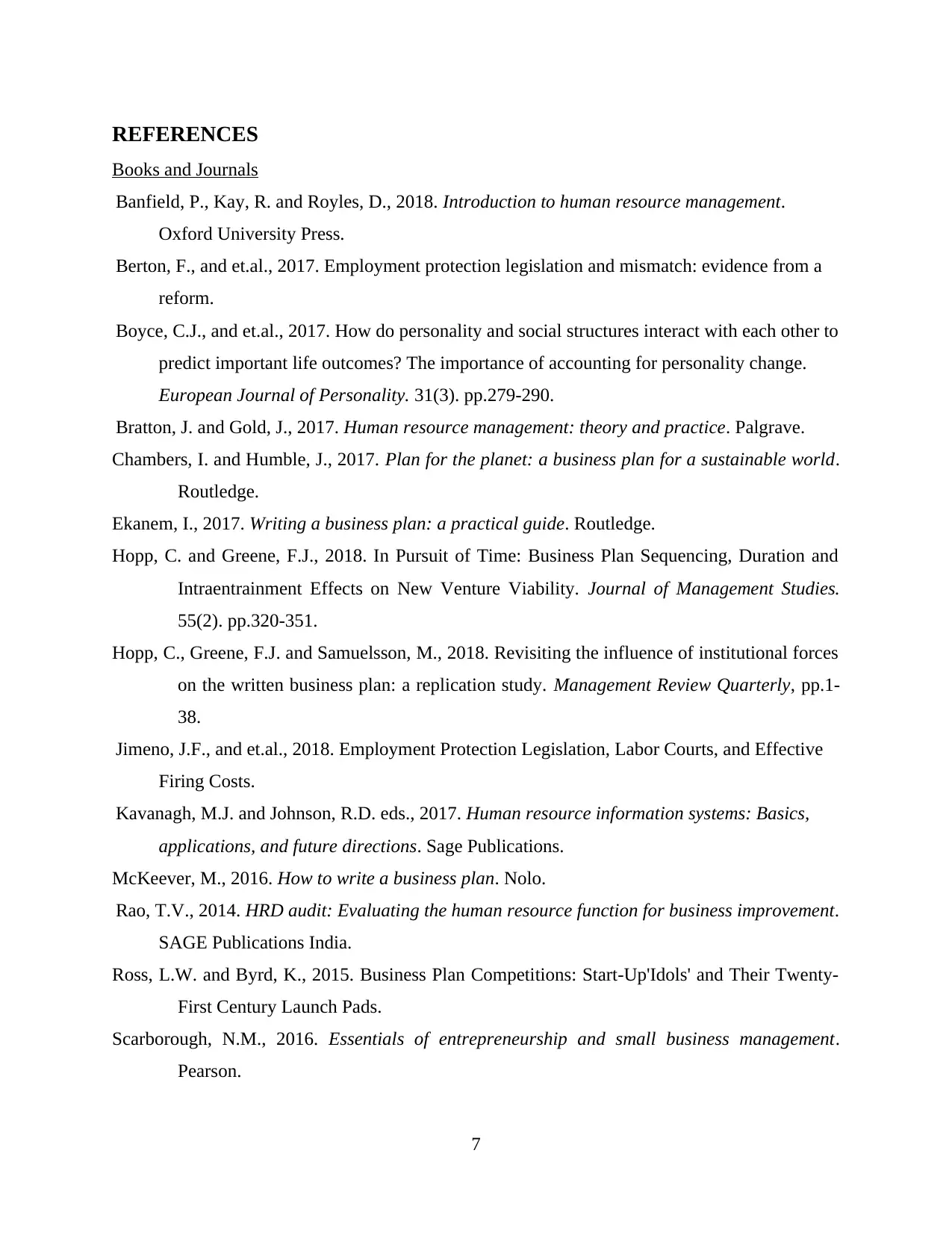
REFERENCES
Books and Journals
Banfield, P., Kay, R. and Royles, D., 2018. Introduction to human resource management.
Oxford University Press.
Berton, F., and et.al., 2017. Employment protection legislation and mismatch: evidence from a
reform.
Boyce, C.J., and et.al., 2017. How do personality and social structures interact with each other to
predict important life outcomes? The importance of accounting for personality change.
European Journal of Personality. 31(3). pp.279-290.
Bratton, J. and Gold, J., 2017. Human resource management: theory and practice. Palgrave.
Chambers, I. and Humble, J., 2017. Plan for the planet: a business plan for a sustainable world.
Routledge.
Ekanem, I., 2017. Writing a business plan: a practical guide. Routledge.
Hopp, C. and Greene, F.J., 2018. In Pursuit of Time: Business Plan Sequencing, Duration and
Intraentrainment Effects on New Venture Viability. Journal of Management Studies.
55(2). pp.320-351.
Hopp, C., Greene, F.J. and Samuelsson, M., 2018. Revisiting the influence of institutional forces
on the written business plan: a replication study. Management Review Quarterly, pp.1-
38.
Jimeno, J.F., and et.al., 2018. Employment Protection Legislation, Labor Courts, and Effective
Firing Costs.
Kavanagh, M.J. and Johnson, R.D. eds., 2017. Human resource information systems: Basics,
applications, and future directions. Sage Publications.
McKeever, M., 2016. How to write a business plan. Nolo.
Rao, T.V., 2014. HRD audit: Evaluating the human resource function for business improvement.
SAGE Publications India.
Ross, L.W. and Byrd, K., 2015. Business Plan Competitions: Start-Up'Idols' and Their Twenty-
First Century Launch Pads.
Scarborough, N.M., 2016. Essentials of entrepreneurship and small business management.
Pearson.
7
Books and Journals
Banfield, P., Kay, R. and Royles, D., 2018. Introduction to human resource management.
Oxford University Press.
Berton, F., and et.al., 2017. Employment protection legislation and mismatch: evidence from a
reform.
Boyce, C.J., and et.al., 2017. How do personality and social structures interact with each other to
predict important life outcomes? The importance of accounting for personality change.
European Journal of Personality. 31(3). pp.279-290.
Bratton, J. and Gold, J., 2017. Human resource management: theory and practice. Palgrave.
Chambers, I. and Humble, J., 2017. Plan for the planet: a business plan for a sustainable world.
Routledge.
Ekanem, I., 2017. Writing a business plan: a practical guide. Routledge.
Hopp, C. and Greene, F.J., 2018. In Pursuit of Time: Business Plan Sequencing, Duration and
Intraentrainment Effects on New Venture Viability. Journal of Management Studies.
55(2). pp.320-351.
Hopp, C., Greene, F.J. and Samuelsson, M., 2018. Revisiting the influence of institutional forces
on the written business plan: a replication study. Management Review Quarterly, pp.1-
38.
Jimeno, J.F., and et.al., 2018. Employment Protection Legislation, Labor Courts, and Effective
Firing Costs.
Kavanagh, M.J. and Johnson, R.D. eds., 2017. Human resource information systems: Basics,
applications, and future directions. Sage Publications.
McKeever, M., 2016. How to write a business plan. Nolo.
Rao, T.V., 2014. HRD audit: Evaluating the human resource function for business improvement.
SAGE Publications India.
Ross, L.W. and Byrd, K., 2015. Business Plan Competitions: Start-Up'Idols' and Their Twenty-
First Century Launch Pads.
Scarborough, N.M., 2016. Essentials of entrepreneurship and small business management.
Pearson.
7
Paraphrase This Document
Need a fresh take? Get an instant paraphrase of this document with our AI Paraphraser
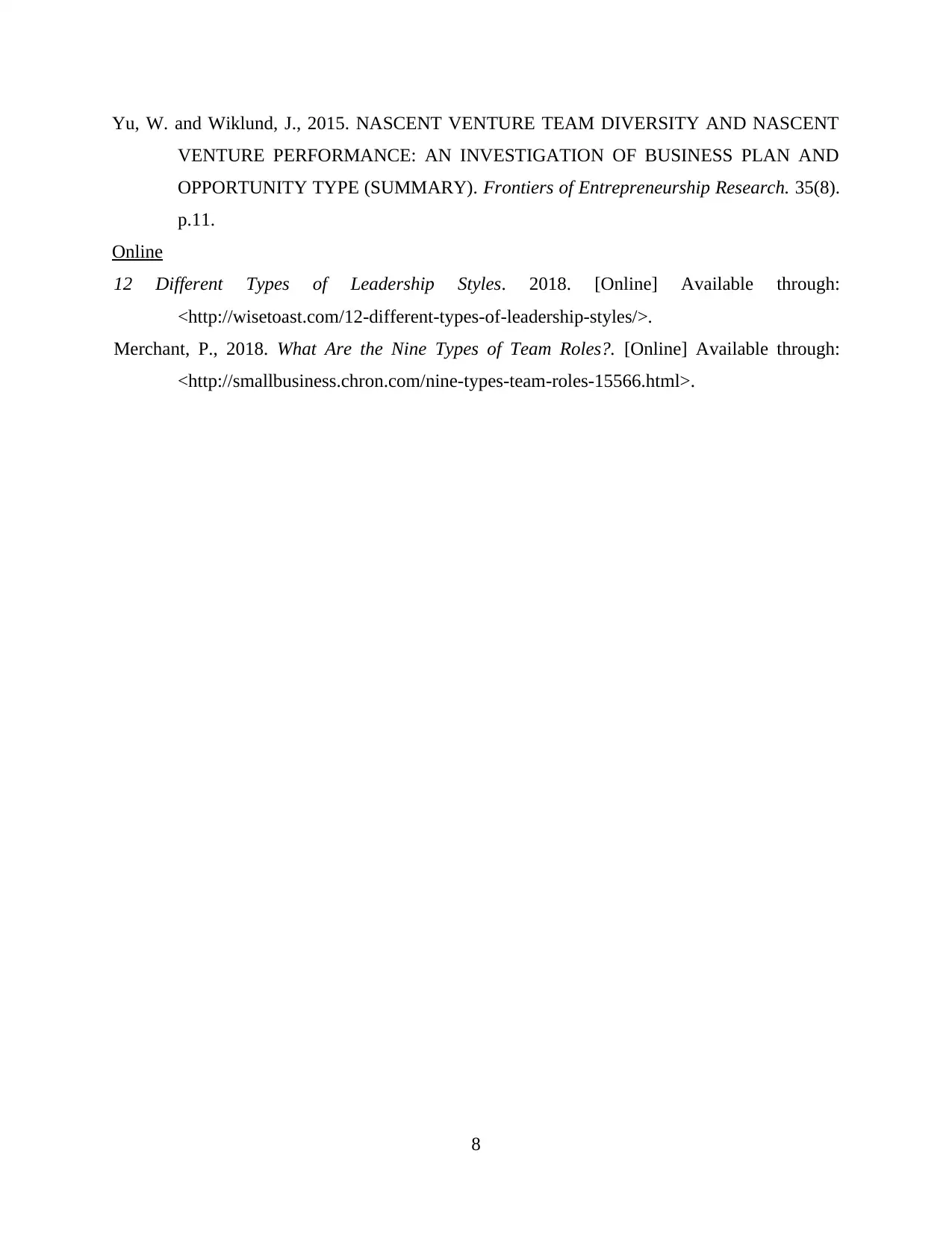
Yu, W. and Wiklund, J., 2015. NASCENT VENTURE TEAM DIVERSITY AND NASCENT
VENTURE PERFORMANCE: AN INVESTIGATION OF BUSINESS PLAN AND
OPPORTUNITY TYPE (SUMMARY). Frontiers of Entrepreneurship Research. 35(8).
p.11.
Online
12 Different Types of Leadership Styles. 2018. [Online] Available through:
<http://wisetoast.com/12-different-types-of-leadership-styles/>.
Merchant, P., 2018. What Are the Nine Types of Team Roles?. [Online] Available through:
<http://smallbusiness.chron.com/nine-types-team-roles-15566.html>.
8
VENTURE PERFORMANCE: AN INVESTIGATION OF BUSINESS PLAN AND
OPPORTUNITY TYPE (SUMMARY). Frontiers of Entrepreneurship Research. 35(8).
p.11.
Online
12 Different Types of Leadership Styles. 2018. [Online] Available through:
<http://wisetoast.com/12-different-types-of-leadership-styles/>.
Merchant, P., 2018. What Are the Nine Types of Team Roles?. [Online] Available through:
<http://smallbusiness.chron.com/nine-types-team-roles-15566.html>.
8
1 out of 11
Related Documents
Your All-in-One AI-Powered Toolkit for Academic Success.
+13062052269
info@desklib.com
Available 24*7 on WhatsApp / Email
![[object Object]](/_next/static/media/star-bottom.7253800d.svg)
Unlock your academic potential
Copyright © 2020–2025 A2Z Services. All Rights Reserved. Developed and managed by ZUCOL.





